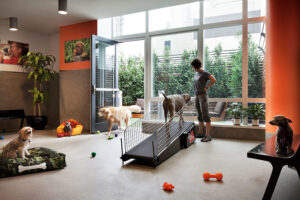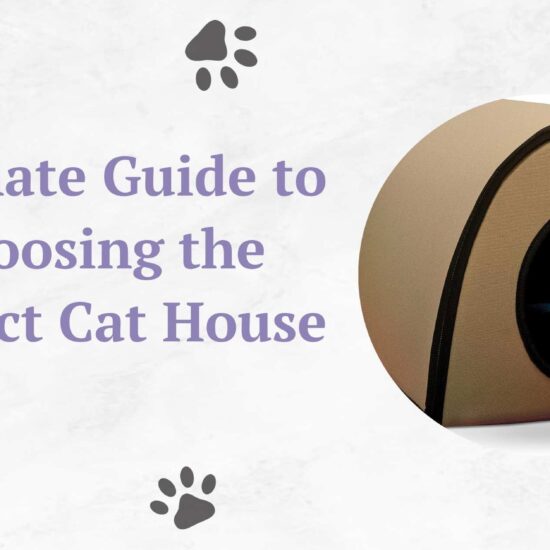As pet ownership grows around the world, the demand for pet-friendly accommodations has never been greater. Whether you’ve had pets your entire life or are thinking about getting one, choosing a suitable house that fits your pets is crucial for their well-being and your peace of mind.
Table of Contents
Introduction
This thorough article will cover all you need to know about the best pet friendly places to stay, from the search process to providing a pleasant home for your pets.
Search for Pet Friendly Housing

While searching for the best pet friendly places to stay for your dogs or cats, consider the following aspects:
- Understanding the Value of Pet-Friendly Living

Pets have evolved from mere companions to valued members of our families in today’s culture. This shift in mindset has resulted in an increase in demand for pet-friendly accommodations. Understanding the significance of pet friendly houses is critical for both pets and their owners’ well-being.
Pet Ownership is Increasing: Pet ownership is increasing around the world, with more people opting to open their homes and hearts to animals. The numerous physical and psychological benefits that pets provide to their owners are fueling this expanding trend. They provide companionship, alleviate stress, and may even improve general health. As a result, finding a home for these cherished pets has become a key priority for many individuals and families.
Advantages of Living in Pet-Friendly Housing: There are various advantages to living in a pet-friendly environment. For starters, it promotes family unity by allowing pets to fully integrate into the household. Pets are happier and healthier when they are not treated as second-class citizens in the home. Second, pet friendly houses fosters a community of like-minded people who share a passion for animals. This sense of community can lead to long-lasting friendships and a welcoming neighborhood.
Pet Owners Without Appropriate Homes Face Difficulties: Life can be difficult for pet owners who do not have access to pet friendly houses. They may be forced to live in too small spaces or under stringent pet restrictions, which can lead to behavioral issues and increased stress for both pet and owner. Furthermore, the process of obtaining pet-friendly accommodation might be difficult. When looking for acceptable housing, many pet owners face discrimination and restrictions. Recognizing the significance of pet friendly housing is crucial in campaigning for pet-friendly housing policies.
- Looking for Pet-Friendly Housing Options

While looking for dog friendly houses, you must consider the following factors.
Online Platforms and Resources: The digital age has transformed the way we search for housing, making it easier than ever to identify pet-friendly solutions. Several websites and platforms specialize in listing pet-friendly rental properties. These platforms frequently include filters that allow users to narrow their searches based on specific pet policies, ensuring that you can find homes that are comfortable with your four-legged friends.
Word-of-Mouth suggestions: In your search for the best pet friendly places to stay, word-of-mouth suggestions might be a valuable resource. If you have pet-owning friends or acquaintances who have successfully found pet-friendly housing, their advice can be beneficial. They may share their knowledge, advising on which communities welcome pets and which landlords are sympathetic and accommodating.
Working with Pet-Friendly Real Estate Agents: Working with pet-friendly real estate agents might be beneficial in your house hunt. These professionals have deep knowledge of local pet-friendly housing options and can provide expert advice on successfully navigating the rental market. Their knowledge can help you save time, streamline your search, and boost your chances of finding the perfect pet friendly house.
Making Your Home Pet Friendly
Creating a pet-friendly atmosphere in your house is critical for both your pet’s health and your peace of mind. This section looks into numerous areas of planning your living space to ensure that your cherished pets are comfortable and safe.
- Pet Safety and Home Design

Home Layout: When planning the layout of your home, consider how it will accommodate your pets. Make sure they have ample room to roam around, especially in high-traffic areas. Pet-friendly floor plans may incorporate open rooms, designated play areas, and easy access to outdoor regions.
Pet Safety: When designing your home layout, safety should be a primary priority. Determine potential hazards, such as hazardous plants, sharp objects, or unstable furniture layouts. Make safe zones for your pets and restrict access to harmful places with baby gates or pet barriers. Safeguard cabinets housing chemicals or hazardous materials to keep curious pets out of harm.
- Flooring Options for Pet-Friendly Residences

Pet-Friendly Flooring Options: Choosing the correct flooring is crucial for keeping your pet-friendly home clean and comfortable. Choose flooring materials that are long-lasting and simple to clean, such as hardwood, laminate, or tile. These alternatives are scratch- and accident-resistant, making them suitable for pet-friendly homes.
Maintenance and Cleaning Tips: It is critical to clean your pet-friendly floors on a regular basis to keep them in good shape. Purchase a high-quality vacuum cleaner that can pick up pet hair and dander. Clean up any spills or accidents as soon as possible to avoid discoloration or odors. To reduce wear and tear, consider utilizing area rugs or floor coverings in high-traffic pet areas.
- Décor and Furniture

Pet-Friendly Furniture Materials: Pet owners must choose the correct furniture materials. Choose furniture made of pet-friendly fabrics that are scratch-resistant and easy to clean. Leather and microfiber are excellent choices because they trap less pet hair and odors. Consider coverings that can be readily removed and washed as well.
Stylish Pet-Friendly Design Ideas: Pet-friendly design does not have to be boring. Include pet-friendly design elements like pet-themed artwork, pet beds that match your decor, and stylish pet crates that double as furniture. Including pet-friendly elements in your overall design creates a more harmonious and visually appealing living space.
- Making Your Home Safe for Pets

Hazardous Substances and Plants: Identifying and removing potential hazards is part of pet-proofing your house. Ensure that all harmful substances, such as cleaning supplies, medications, and chemicals, are safely placed out of reach of your pet. Indoor plants that are poisonous to pets should be removed or replaced.
Electrical Wire Management: It is common for pets, particularly puppies and kittens, to chew on electrical cables, posing a serious safety danger. Invest in cord shields, hide cords behind furniture or use cable management solutions to keep your dogs away from them.
Designating a Pet Space: Set aside a separate location in your home for your pets to eat, play, and relax. This helps to establish limits and arrange your pet’s things. Include in this allocated space their food and drink stations, toys, and a comfy bed or crate.
- Pet Supplies That Are Required

Food and Water Stations: Set aside a space in your home for your pet’s food and water dishes. Choose easy-to-clean, non-slip bowls that are the right size for your pet. Regularly clean and sanitize these bowls to preserve hygiene.
Pleasant Pet Beds and Crates: Every pet deserves a pleasant place to rest. Invest in quality pet beds or cages that suit your pet’s size and preferences. Crates can serve as a safe sanctuary for your pet and aid with housetraining.
Toys and Enrichment Equipment: Keep your pets mentally and physically occupied with a selection of toys and enrichment equipment. To reduce boredom and maintain a healthy, happy pet, provide puzzle toys, interactive activities, and toys that stimulate exercise.
Pet Friendly Outdoor Spaces
Outdoor spaces are critical to ensuring your pets’ well-being and pleasure. Giving your pets access to safe and interesting outdoor settings can dramatically improve their quality of life. In this section, we will look at the most important components of outdoor places for pets.
- Outdoor Area Access

Pets require access to outside places in order to engage in natural behaviors, gain exercise, and enjoy fresh air. Consider the following criteria, whether you reside in an apartment, house, or community:
Balconies and Patios in Apartments: If you live in an apartment, balconies and patios can be important outdoor spaces for your pets. Install solid railings or obstacles to avoid accidental falls in these areas. To create a comfortable and sanitary atmosphere, choose pet-friendly flooring such as artificial grass or outdoor pet mats.
Fenced Yards and Common Green Spaces: Houses with fenced yards give pets the most outside freedom, allowing them to play and explore while being safe. If you live in a neighborhood with common green spaces, make sure they are pet-friendly and well-kept. Encourage responsible pet ownership by cleaning up after your pets to keep the neighborhood tidy for all inhabitants.
- Pet-Friendly Gardening

Landscape your outside space with your pets in mind to create a paradise for both humans and animals. Consider the following pet-friendly landscaping ideas:
Pet-Friendly Plants and Landscaping Materials: Select pet-friendly plants and landscaping materials that will not damage your pets if swallowed. Avoid plants that are harmful, such as lilies, azaleas, and oleanders. Choose materials that are pleasant for pets to walk on and do not offer choking dangers, such as mulch or gravel.
Adding Pet-Friendly Elements: Include pet-friendly elements in your landscaping, such as specific play spaces, dog runs, and shaded areas. A dog run can provide an enclosed location for exercise, while shaded sections or dog houses keep your pets safe from inclement weather.
Planting a Pet-Friendly Garden: If you enjoy gardening, plant a pet-friendly garden by planting pet-safe herbs, fruits, and vegetables. To satisfy your dog’s natural digging impulses, create a specific digging area with soft dirt or sand.
- Facilities in the Neighborhood

The amenities in your community can significantly improve your pets’ lives and well-being. Take into account the following neighborhood factors:
Proximity to Pet Parks and Walking Trails: Living near pet parks, walking trails, and nature reserves can offer your pets plenty of exercise and socialization possibilities. Outings to these locations on a regular basis keep your pets active, healthy, and mentally stimulated.
Pet-Friendly Neighbors and Community Events: Connecting with pet-friendly neighbors and attending community events can help your pets’ social lives. To develop a sense of community, organize play dates or join local pet clubs. Furthermore, many areas hold pet-related events such as adoption drives and pet-friendly festivals, which can be both entertaining and educational for pet owners.
Access to Local Pet Services and Businesses: Having access to local pet services such as veterinarian clinics, groomers, and pet supply stores ensures that your pets’ needs are met in a timely and convenient manner. Supporting local businesses that cater to pets helps to strengthen your neighborhood’s pet-friendly culture.
Pet Etiquette in Public Places
Living in a pet-friendly neighborhood includes the obligation to practice excellent pet etiquette in order to maintain harmony among inhabitants and their canine friends. In this section, we’ll look at the most important components of maintaining pet etiquette in public places.
- Pet-Friendly Community Common Areas

There are several common areas in pet-friendly communities that all residents share. Consider the following principles to ensure that these locations stay enjoyable for everyone:
Corridors and Elevators: When utilizing corridors and elevators, keep your pet on a leash or in a carrier to avoid accidental contact with other residents or their pets. If your pet has an accident, always clean up after them.
Laundry Rooms and Lobbies: Be considerate of others when utilizing common facilities such as laundry rooms or lobbies. If your pet becomes frightened or agitated when exposed to strangers or other animals, consider doing your laundry when these locations are less populated.
Pet Waste Disposal: Use authorized pet waste disposal places and clean up after your pet as soon as possible. Leaving pet excrement in public locations is not only ugly but also unsanitary and impolite.
Note: There might be affiliate links mentioned here. We may receive a commission if you purchase a product through an affiliate link. There is no additional charge for you. Please do your own research before making any online purchases.
- Noise and Behavior Control

Excessive noise and disruptive behavior from pets can damage relationships with neighbors. It is critical to practice noise and behavior management:
Barking and Noisy Pets: Excessive barking or noise from your pet can be upsetting to your neighbors. To minimize disturbances, address this issue through training and socialization. If required, seek the advice of a professional trainer or behaviorist.
Handling Aggressive or Anxious Pets: Take steps to manage and address your pet’s aggressive or anxious behavior. This may entail walking with a leash or muzzle and getting professional help to address underlying issues.
Training and Socialization Tips: Regular training and socialization are essential for ensuring your pet behaves appropriately in public places. Enroll in obedience lessons and expose your pet to numerous locations and circumstances to increase their confidence and lessen their anxiety.
- Respecting Your Neighbors

Respecting your neighbors and their needs is vital to sustaining a harmonious living environment:
Open Communication with Neighbors: Establish open lines of communication with your neighbors. If your pet ever causes a disturbance, neighbors are more likely to be understanding if you communicate and handle the situation swiftly.
Apologizing for Any Disturbances: If your pet mistakenly causes any disturbances or inconveniences, be proactive in apologizing and making apologies. A simple apology can go a long way toward sustaining friendly neighborly relations.
Encouraging a Sense of Community: Foster a sense of community among pet owners by hosting pet-friendly events or gatherings. Building friendships with neighbors who share your love for pets can create a supportive and empathic culture within the community.
Legal and Ethical Considerations
Navigating the legal and ethical elements of pet ownership and housing is vital to creating a harmonious coexistence in pet-friendly communities. This section discusses several aspects of this domain.
- Leases and Pet Clauses

Leases and pet clauses are legal contracts that govern the terms of your lease as well as any pet-related conditions:
Understanding Lease Terms: Before signing, carefully read and comprehend your lease agreement. Pay close attention to pet-related provisions, such as pet deposits, pet rent, and any limitations on the number, size, or type of pets permitted.
Negotiating Pet-Friendly Lease Clauses: If your lease does not include pet-friendly clauses, talk to your landlord or property manager about it. You should be prepared to give references, pet resumes, and proof of responsible pet ownership.
Legal Rights and Duties: In pet friendly houses, both landlords and tenants have legal rights and duties. Understanding these rights and obligations is critical for avoiding problems and ensuring that both parties have a great living experience.
- Weight and Breed Restrictions

Pet breed and weight limitations are imposed in some housing complexes. Take a look at the following:
Dealing with Breed-Specific Policies: Some towns may prohibit specific dog breeds that they deem “dangerous.” If you own a breed that is restricted, it’s critical that you understand these policies and their ramifications.
Weight Limitations: Weight limitations may limit the size of dogs permitted in specific apartments or neighborhoods. To avoid problems with your landlord, make sure your pet follows these rules.
Fighting Unreasonable Limits: If you believe that breed or weight limits are unreasonable, you can campaign for policy reforms or join with local animal welfare organizations to oppose discriminatory practices.
- Animals That Provide Service and Emotional Support

It is critical to understand the distinctions between service animals, emotional support animals (ESAs), and pets:
Recognizing Legal Service Animals: Service animals are specially trained to fulfill certain activities for people with disabilities. They have broad legal access rights, including housing. It is important to understand that service animals are not pets.
Emotional Support Animal Documentation: ESAs provide emotional support to people suffering from mental illnesses. Although they may be subject to housing regulations, they are not considered service animals. ESAs normally require proper paperwork from a competent mental health specialist.
Your Legal Rights and Duties: As a pet owner, service animal handler, or ESA owner, it’s critical to understand your legal rights and duties. Maintain legal compliance while fighting for your needs.
- Liability Insurance for Pets

Pet liability insurance is a type of coverage that can shield you and your landlord from the financial ramifications of pet-related incidents.
Importance of Liability Insurance: Liability insurance is critical for pet owners because it provides coverage in the event that your pet causes bodily harm or property damage. To mitigate hazards, many landlords require tenants to purchase this insurance.
Obtaining a Pet Liability Policy: Inquire with insurance providers about pet liability insurance choices. Depending on characteristics such as your pet’s breed and history, policies often have varying coverage limitations and rates.
Coverage Alternatives and Costs: Investigate several coverage alternatives to decide the level of protection you require. The cost of pet liability insurance varies, so get quotes from several insurers to find a policy that fits your budget and needs.
Developing Good Relationships with Landlords and Neighbors
Maintaining great relationships with landlords and neighbors is critical for a peaceful living environment, particularly in pet-friendly neighborhoods.
- Interaction with Landlords

Open and honest communication with your landlord or property manager is essential for keeping your pet friendly housing arrangement mutually beneficial.
Addressing Pet-Related Concerns: Be proactive in discussing any pet-related concerns you may have with your landlord. Answer their questions or concerns honestly, and assure them that you will be a responsible pet owner.
Reporting and Resolving Issues: If problems emerge with your pet or his or her behavior, notify your landlord or property management as soon as possible. Be proactive in resolving any issues and demonstrating your dedication to a secure and quiet living environment.
Establishing Trust: Establishing trust with your landlord goes a long way toward guaranteeing a great experience for both parties. Pay rent on time, keep the property in good condition, and follow all pet-related policies and agreements.
- Interacting with Neighbors

In a pet-friendly environment, being a caring neighbor is critical for establishing a sense of community and cooperation.
Introducing Your Pets: If you have a new pet, introduce it to your neighbors to get them acquainted with your new companion. This can assuage any worries your neighbors may have about your pet.
Organizing Pet-Friendly Events: Consider organizing or participating in pet-friendly community events such as dog walks or playdates. These events might help you connect with other residents and build your sense of community.
Resolving Arguments Amicably: If arguments or disputes emerge with neighbors about your pet’s behavior, approach them in a calm and respectful manner. Find a middle ground and, if required, use the help of your landlord or property management to resolve the matter.
Pleasures of Pet Ownership in a Pet Friendly Environment

Finding the best pet friendly places to stay has numerous advantages for both pet owners and their cherished animals. In this section, we’ll go over these benefits as well as the significance of continual care and attention for your pets.
- Advantages of Pet Friendly House
Pet-friendly housing fosters an atmosphere where pets can thrive and their owners can fully enjoy the pleasures of pet ownership.
Improved Pet and Owner Well-Being: Pets thrive in homes where they are treated as family members rather than just accessories. Your pets will be able to enjoy the companionship and love they require for a happy existence in pet-friendly homes. Pet owners have reduced stress and enhanced mental well-being as a result of the link they share with their dogs.
Creating a Loving and Supportive Community: Pet-friendly housing frequently attracts like-minded people who have a strong affinity for animals. This sense of community creates ties and friendships among neighbors who can relate to one another’s pet-owner joys and challenges.
Pleasure of Responsible Pet Ownership: Responsible pet ownership is not only encouraged but also celebrated in pet-friendly homes. This includes giving your pets proper care, regular veterinary visits, exercise, and a safe and supportive environment. The gratification that comes from knowing you are a responsible pet owner is indescribable.
- Constant Monitoring and Care
While pet-friendly housing is wonderful for your dogs, it’s important to remember that pet ownership is a lifelong commitment.
Vaccinations and Regular Visits to Vet: Keep your pets’ health and well-being in check by scheduling regular veterinary visits and keeping up with vaccinations and preventive care. Regular check-ups ensure early detection of health issues and contribute to your dog living a longer, happier life.
Proper Nutrition and Exercise: Make sure your pets get a well-balanced diet and enough exercise to keep them physically fit and mentally stimulated. Consult your veterinarian to determine the best diet and exercise routine for your pet’s specific requirements.
Mental Stimulation and Company: In order to grow, pets require mental stimulation and company. Play, train, and socialize your pets to spend meaningful time with them. By providing toys, puzzles, and enrichment activities, you can prevent boredom and behavioral issues.
FAQs
Can I bring any kind of pet to a pet-friendly apartment complex?
Because pet laws differ for each housing community, it’s critical to consult with your landlord or property manager about acceptable pet varieties. Dogs and cats are commonly accepted; however, unusual pets or particular breeds may be restricted.
If I’m moving to a new city, how do I discover the best pet friendly places to stay?
When relocating, begin your search online using pet-friendly rental sites. You can also get help from local animal shelters or rescue organizations, who may know of pet-friendly neighborhoods in your new neighborhood.
What should I do if my pet damages my rental property?
Be prepared to pay for repairs if your pet causes harm. To maintain a pleasant relationship, engage with your landlord about any difficulties and arrange for repairs as soon as possible.
In a pet-friendly rental, do I have to pay a pet deposit or pet rent?
A pet deposit or monthly pet rent is required in many pet-friendly properties. These fees help cover potential damages or increased cleaning costs associated with pets. Check your lease agreement for specific details.
How can I ensure my pet is comfortable during the relocation process?
Make the transition easier for your pet by maintaining as much consistency as possible in their routines, packing their belongings last, and gradually introducing them to the new environment. For more information, speak with your veterinarian.
Are there any pet size restrictions in pet-friendly housing?
Weight restrictions for dogs may apply in some housing communities, particularly in apartments or shared spaces. Before moving in with a larger breed, always inquire about size restrictions.
Can I live in pet-friendly housing with my emotional support animal (ESA)?
ESAs are legally protected under housing laws. While ESAs are usually welcome in pet-friendly housing, you may need to provide appropriate documentation from a mental health professional to ensure compliance with regulations.
How do I socialize my pet in a pet-friendly neighborhood?
Attend community pet events, join local pet clubs, and set up playdates with pet-owning neighbors. These activities can assist your pet in socializing and strengthening community ties.
What should I do if my pet gets into a fight with a neighbor’s pet?
Handle disagreements calmly and respectfully. Communicate with your neighbor to find a solution, and if necessary, consult your landlord or property management. Consider professional mediation if the situation escalates.
Do I need pet liability insurance if I live in pet-friendly housing with my pet?
While it is not always necessary, obtaining pet liability insurance is recommended. It protects you and your landlord in the event that your pet causes harm or damage to others or their property, giving you and your landlord peace of mind.
Conclusion
Finding best pet friendly places to stay and making your pets feel at home is a joyful adventure that requires careful research, negotiation, and a dedication to proper pet care. You may embark on this trip with confidence, knowing that you’re providing the finest possible environment for your beloved animal companions, thanks to the information and recommendations provided in this article. Pet-friendly housing is about creating a happy and peaceful existence for both you and your pets, not just finding a place to live.












